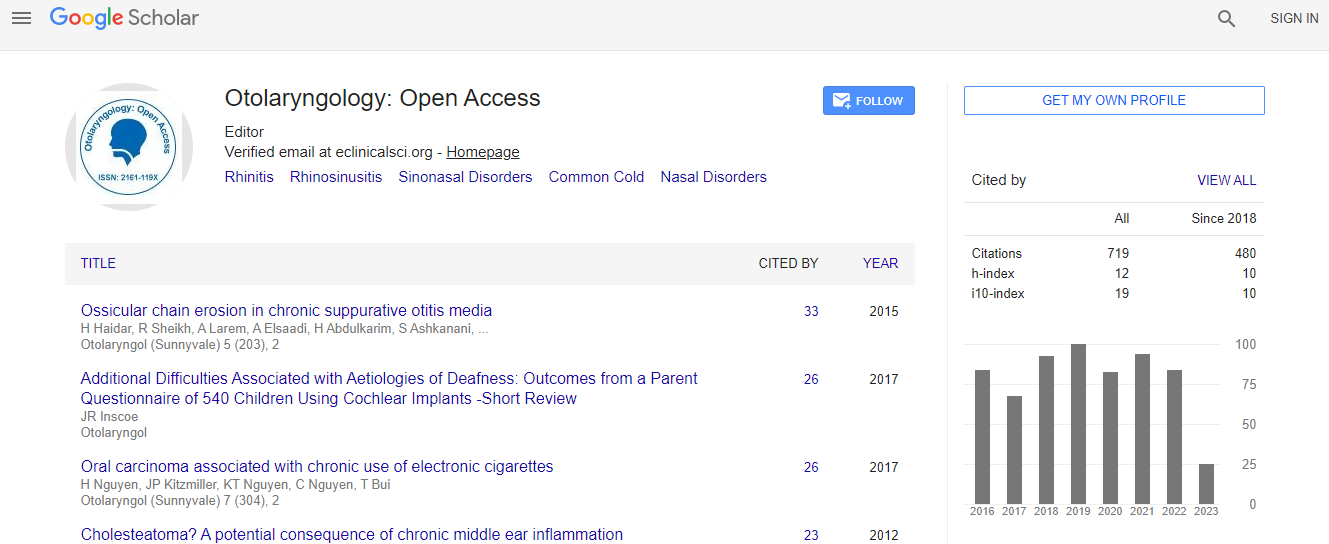Our Group organises 3000+ Global Conferenceseries Events every year across USA, Europe & Asia with support from 1000 more scientific Societies and Publishes 700+ Open Access Journals which contains over 50000 eminent personalities, reputed scientists as editorial board members.
Open Access Journals gaining more Readers and Citations
700 Journals and 15,000,000 Readers Each Journal is getting 25,000+ Readers
Google Scholar citation report
Citations : 925
Otolaryngology: Open Access received 925 citations as per Google Scholar report
Otolaryngology: Open Access peer review process verified at publons
Indexed In
- Index Copernicus
- Google Scholar
- Sherpa Romeo
- Open J Gate
- Genamics JournalSeek
- RefSeek
- Hamdard University
- EBSCO A-Z
- OCLC- WorldCat
- Publons
- Geneva Foundation for Medical Education and Research
- ICMJE
Useful Links
Recommended Journals
Related Subjects
Share This Page
Laser thermal therapy for recurrent head and neck cancer: The UCLA experience
International Conference and Exhibition on Otolaryngology
Marcos Paiva
ScientificTracks Abstracts: Otolaryngology
Abstract
Although major progress has been made in surgery, radiation, and chemotherapy for the treatment of malignancy during the last 30 years, there has been little improvement in the survival of patients with recurrent or advanced head and neck cancer.Laser-induced thermotherapy (LITT) is a non-surgical method for treating tumors in solid organs. The method is experimental and considered primarily in treating patients with recurrent tumors when surgery is not an option.A recent phase II study at our institution showed that palliative LITT for 106 patients with recurrent lesions presented the best results in oral cavity tumors, in which mean survival was 29.1 months, as compared to neck tumors (mean 14.4 +/- 6.9 months; range 7.5-20.7 months; with a 95% confidence interval).Because of the ease and accessibility for surgery and their loco-regional biological behavior, head and neck cancers serve as an ideal model to test combined laser energy delivered via interstitial fiberoptics and chemotherapeutic agents activated by photo-thermal energy as an alternative, less invasive treatment for cancer. A number of investigators have shown that anthracyclines and cisplatin are likely candidates for light or heat activation in cancer cells. Maximum tolerated dose followed by photochemical and thermal activation via laser fiberoptics can improve treatment by sensitizing tumor response. The higher intratumor drug levels compared to systemic drug administration along with laser activation should also reduce systemic toxicity. In this presentation we review the concept of combining anti-cancer drugs and laser therapy and review the clinical experience for this novel application.Biography
Dr. Marcos Paiva's research focuses on the laser and chemotherapy for denaturation of cancer cells, including improving Nd:YAG laser thermal therapy for patients with recurrent head and neck cancer. With continuous funding from the National Cancer Institute (NIH) for the past 17 years, this translational study has progressed introducing a novel experimental treatment for cancer based on the concept of high doses of intratumor injections of chemotherapy (cisplatin) combined with localized infra-red hyperthermia.

 Spanish
Spanish  Chinese
Chinese  Russian
Russian  German
German  French
French  Japanese
Japanese  Portuguese
Portuguese  Hindi
Hindi 
